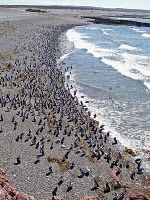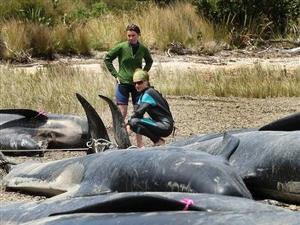VIRGINIA A driver accused of cruelty to animals and in a fine of USD 100 . He was caught carrying a goat in the trunk of his car.Deputy sheriff kote Bedford, Virginia, United States (U.S.) found bound and the goat in the trunk of a car owned by Fiona Ann Enderby. When checked, it turns out she was also drunk driving. Thus reported the Associated Press, Sunday (22/08/2010).When asked the police, the woman was declared if the goats he bought from a farmer who will be given to someone else. We found the goat looked out of breath. When measured, the air in the trunk temparatur is approximately 94 degrees centigrade.
Posts Tagged ‘Zoology’
driver accused of cruelty to animals and in a fine of USD 100 . He was caught carrying a goat in the trunk of his car
Posted: August 22, 2010 in WoWTags: Associated Press, Bedford, Bedford,Virginia,United States, Biology, Culture, Deputy sheriff, driver, farmer, Fiona Ann Enderby, Goat, Human Interest, Law_Crime, Livestock, Meat, Trunk, United States, USD, Virginia, Virginia,United States, Zoology
more than 60 whales were found dead on the Beach Kaitaia in New Zealand
Posted: August 21, 2010 in most wanted terrorists and criminalsTags: Beached whale, Biology, Carolyn Smith, Cetaceans, Disaster_Accident, Environment, Fauna of Asia, Killer Whale, Megafauna, New Zealand, New Zealand Ministry of Nature Protection, Oceanic dolphins, Pilot whale, Whale, Zoology
60 whales died on a beach in New Zealand. Whale that died after it beached.This was disclosed by Carolyn Smith of the New Zealand Ministry of Nature Protection. Carolyn announced that more than 60 whales were found dead on the Beach Kaitaia in New Zealand. Whales can not be saved because rescuers could not save enough time for the whales.
Carolyn guessed it before the fish were stranded at first. He was stranded due to make sure they can not survive. Similarly as reported from all voices, Saturday, August 21, 2010.Carolyn adds there are actually about 73 whales that were stranded but there are some among the fish who saved themselves by returning to the sea.Ministry of Nature Protection explained the type of pilot whales were stranded since Thursday night.
Some volunteers are trying hard to restore the large fish in the sea. But, not easy to do so.whale on the beach of New Zealand is not this just happened the first time only. Last December, about 100 whale also beached in the country and then they can not survive presumed dead.
Hundreds of penguins that apparently starved to death are washing up on the beaches of Brazil
Posted: July 21, 2010 in breaking newsTags: Argentina, biologist, biologist at the Peruibe Aquarium, Birds of Australia, Brazil, Brazilian coast, Chile, Ecology, Environment, Falkland Islands, Flightless birds, food, Grande beach, Itanhaem beach, SAO PAULO, Magellanic Penguin, Nascimento, Ornithology, Penguins, Peruibe beach, Praia beach, Praia Grande beach, Spheniscus, Zoology
SAO PAULO Hundreds of penguins that apparently starved to death are washing up on the beaches of Brazil, worrying scientists who are still investigating what’s causing them to die.About 500 of the black-and-white birds have been found just in the last 10 days on Peruibe, Praia Grande and Itanhaem beaches in Sao Paulo state, said Thiago do Nascimento, a biologist at the Peruibe Aquarium.Most were Magellan penguins migrating north from Argentina, Chile and the Falkland Islands in search of food in warmer waters.
 Many are not finding it: Autopsies done on several birds revealed their stomachs were entirely empty – indicating they likely starved to death, Nascimento said.Scientists are investigating whether strong currents and colder-than-normal waters have hurt populations of the species that make up the penguins’ diet, or whether human activity may be playing a role.”Overfishing may have made the fish and squid scarcer,” Nascimento said.Nascimento said it’s common for penguins to swim north this time of year. Inevitably, some get lost along the way or die from hunger or exhaustion, and end up on the Brazilian coast far from home.But not in such numbers – Nascimento said about 100 to 150 live penguins show up on the beach in an average year, and only 10 or so are dead.”What worries us this year,” he said, “is the absurdly high number of penguins that have appeared dead in a short period of time.”(AP)
Many are not finding it: Autopsies done on several birds revealed their stomachs were entirely empty – indicating they likely starved to death, Nascimento said.Scientists are investigating whether strong currents and colder-than-normal waters have hurt populations of the species that make up the penguins’ diet, or whether human activity may be playing a role.”Overfishing may have made the fish and squid scarcer,” Nascimento said.Nascimento said it’s common for penguins to swim north this time of year. Inevitably, some get lost along the way or die from hunger or exhaustion, and end up on the Brazilian coast far from home.But not in such numbers – Nascimento said about 100 to 150 live penguins show up on the beach in an average year, and only 10 or so are dead.”What worries us this year,” he said, “is the absurdly high number of penguins that have appeared dead in a short period of time.”(AP)
Nadia Bloom. After missing four days, he was eventually found alive in a swamp in Winter Springs
Posted: April 17, 2010 in WoWTags: Alias episodes, Crocodiles, Crocodylidae, Florida, Florida,United States, Herpetology, hotel at Florida, Jeff Bloom, King, Nadia, Nadia Bloom, traveling to Florida, United States, visiting Florida, WINTER SPRINGS, Zoology
 WINTER SPRINGS The Miracle of life really overshadow Nadia Bloom. After missing four days, he was eventually found alive in a swamp in Winter Springs, Florida, United States, Wednesday (14 / 4) then.Autistic woman was found in the mud bog that became very vicious crocodile habitat. Nadia the besieged dozens of vicious crocodile is reportedly for five days did not suffer serious injuries although severely dehydrated and mosquito bites.
WINTER SPRINGS The Miracle of life really overshadow Nadia Bloom. After missing four days, he was eventually found alive in a swamp in Winter Springs, Florida, United States, Wednesday (14 / 4) then.Autistic woman was found in the mud bog that became very vicious crocodile habitat. Nadia the besieged dozens of vicious crocodile is reportedly for five days did not suffer serious injuries although severely dehydrated and mosquito bites.
The girl was found by a friend of Nadia’s father, when they wanted to keep track of these swamps. “God seemed to direct me to find Nadia,” explained King. Nadia missing Friday (9 / 4) while out cycling, making a video about nature.
Nadia’s father, Jeff Bloom, said she and the authorities have to find her son to use radar, helicopters, dive teams, volunteers until golden retriever. Since crowded as the swamp, the officers took 1.5 hours to lift the body of Nadia.11-year-old girl appeared calm. He admitted that he only slept for two hours during the sunset in the swamp. Nadia had seen some fierce snake, but his body was not touched by the crocodile.
giant crocodiles from 100 million years
Posted: November 25, 2009 in EducationsTags: 3ft-long flat head, Biology, Croc, Crocodiles, Crocodylidae, Dinosaur, Environment, films, food, giant crocodiles, Hans Larsson, Herpetology, Killer Croc, McGill University, Montreal, Morocco, Niger, Paul Sereno, professor, Sahara, the University of Chicago, University of Chicago, Zoology
Rat Croc, Duck Croc and Pancake Croc. These are not the names of children’s cartoon characters, but giant crocodiles from 100 million years, ago, whose fossilised remains palaeontologists have unearthed in the Sahara.The crocodiles once ran and swam in present-day Niger and Morocco, when the region was covered by lush plains and broad rivers, as agile on land as they were in water.The palaeontologists say that the diverse array of fossils that they found offers important clues to why the ancestors of modern crocodiles survived while dinosaurs underwent mass extinction.The expedition, which began in 2000, found specimens of four new species, nicknamed Boar Croc, Pancake Croc, Duck Croc and Rat Croc. Many of the fossils were found lying on the surface of a remote, windswept stretch of rock and dunes.The discoveries, which are described today in the journal Zookeys, show that early crocodiles were much more varied in physique and behaviour than their modern ancestors.They were given nicknames by the scientists, based on their unusual physical features.
Boar Croc (Kaprosuchus saharicus) was a ferocious 20ft-long (6m) meat eater with an armoured snout for ramming and three sets of dagger-shaped fangs for slicing.Rat Croc (Araripesuchus rattoides) was 3ft long and used its bucktoothed lower jaw to dig for roots and grubs.Pancake Croc (Laganosuchus thaumastos) was a 20ft-long squat fish eater, with a 3ft-long flat head. It would have rested, motionless, for hours, waiting for prey to swim into its open jaws.
Duck Croc (Anatosuchus minor) was a 3ft upright species that ate fish, frogs and grubs. It had a broad, overhanging snout. Sensory areas on the snout helped it to root around shallow waters for prey.The team, led by Paul Sereno, of the University of Chicago, and Hans Larsson, of McGill University, Montreal, also found the most complete example of a previously discovered species, nicknamed Dog Croc. Dog Croc (Araripesuchus wegeneri) was a 3ft-long upright plant and grub eater with a soft, doglike forward-pointing nose.Yesterday Professor Sereno described Duck Croc as the “Pinocchio of crocs”, adding that its nose was more than just a physical flourish. Evidence of soft tissue in Duck Croc’s nose suggests that it had a highly advanced sense of smell.
Dr Larsson said: “We were surprised to discover so many species from the same time in the same place.”The fossils all date from about 100 million years ago, a time when dinosaurs still dominated the Earth.With the exception of the Pancake Croc, scientists believe all of the ancient species walked upright, like a land mammal, rather than with their limbs sprawled out to the sides and their bellies touching the ground.The animals would have been able to gallop on land, although scientists have not yet established how fast they were. Professor Sereno said: “We don’t think these animals were racehorses but they were pretty fast.“A human would have had a harder time outrunning them than they would a modern crocodile.”
Their skeletal remains suggest that the early crocodiles were already well-adapted swimmers, with agile tails and paddling claws.This early versatility may explain how crocodiles came to be the largest air-breathing survivors of the mass extinction event of about 65 million years ago that wiped out terrestrial dinosaurs. “Their amphibious talents in the past may be the key to understanding how they flourished in, and ultimately survived, the dinosaur era,” said Professor Sereno.Being semi-aquatic may have made it easier for them to scavenge from the carcasses of dead marine life. Modern crocodiles can live as scavengers and can survive for months without food.

